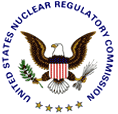 |
NRC NEWS
U. S. NUCLEAR REGULATORY COMMISSION |
| Office of Public Affairs |
Telephone: 301/415-8200 |
| Washington, DC 20555-001 |
E-mail: opa@nrc.gov |
No. 99-87
April 28, 1999
NUCLEAR POWER PLANTS ON TRACK FOR ACHIEVING Y2K COMPLIANCE BY JULY 1
An audit of measures taken by 12 nuclear power plants to address potential computer problems
at the start of the Year 2000 shows they are on schedule to meet the readiness target date of
July 1.
No problems were found at the plants that will interfere with the ability of their computers to
control key safety systems starting next year. The on-site audits were conducted by the Nuclear
Regulatory Commission between last September and January of this year.
The "Year 2000" or Y2K problem, refers to computers' potential inability to recognize dates
beginning with January 1, 2000, and beyond. It is caused by computer programs that use
two-digit numbers to represent a calendar year (such as "98" for 1998). If the problem is not
corrected, vulnerable computer systems will read "00" as 1900, rather than 2000, potentially
causing some plant systems or equipment to malfunction.
The plants audited included Brunswick (North Carolina), Hope Creek (New Jersey), Davis
Besse (Ohio), Wolf Creek (Kansas), Monticello (Minnesota), Seabrook (New Hampshire), Watts
Bar (Tennessee), Limerick (Pennsylvania), Waterford (Louisiana), North Anna (Virginia),
Braidwood (Illinois), and WNP-2 (Washington State). They were chosen on the basis of design,
geographic location and age to be generally representative of all 103 operating nuclear plants.
Because licensee Y2K programs are corporate-wide, many of the NRC staff audits include more
than a single nuclear power plant site, since many utilities own more than one nuclear plant.
Hence, theY2K programs for 42 of the 103 operating power plants are included in the audits.
Results of these audits and a copy of the Information Notice sent by NRC to its licensees
summarizing its findings will be posted to the NRC website at:
http://www.nrc.gov/NRC/NEWS/year2000.html
NRC has no indication that Y2K computer-related problems exist with safety-related systems in
nuclear power plants. Most commercial nuclear plants have protection systems that do not rely
on computer dates and hence, are not vulnerable to the Y2K "bug." However, the audits did
identify some problems in non-safety, but important computer-based applications that use
embedded computer chips vulnerable to the Y2K problem. These include computer systems
used to control personnel access systems within the plants, control room display systems,
engineering programs, control systems, radiation monitoring systems, and emergency response
systems. In some instances, work on these systems may not be completed until the fall.
At the time of the audits, most NRC licensees were just beginning work on contingency plans to
deal with unforseen Y2K problems. The NRC plans to assess the effectiveness of contingency
plans during reviews to be conducted over the next few months at six other nuclear power plant
sites - Palo Verde (Arizona), Oconee (South Carolina), Duane Arnold (Iowa), Indian Point 2
(New York), Turkey Point (Florida), and Diablo Canyon (California).
Licensees are also planning for the possible loss of off-site communications and the loss of off-site power in the event of instabilities of the electric power grids, the audits found. Although
NRC regulatory oversight and authority does not extend to the U.S. electric power grid system,
the agency recognizes the national importance of providing electricity to customers during the
January 1, 2000 transition. Therefore, NRC has taken an interest in this matter and has
received assurances from the North American Electric Reliability Council that it is working with
NRC licensees to develop plans for handling generation and transmission problems.
Beginning this month, NRC inspectors will review Y2K programs at all 103 reactors - including
those previously audited, to gather information that will be used to evaluate licensee Y2K
readiness letters. Summaries of the results of those reviews will be made publicly available and
will be posted on the NRC website. By July 1, licensees must submit written confirmation to NRC
that their plants are or will be Year 2000 ready at the turn of the century and if not, must provide
a status report, including detailed completion schedules for remaining work to ensure Year 2000
readiness.
|
